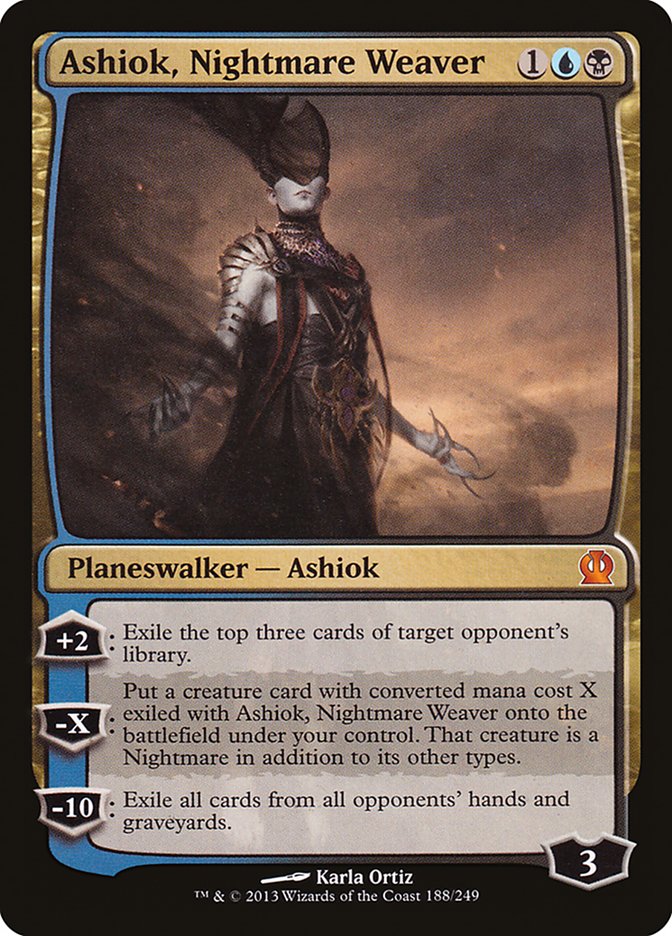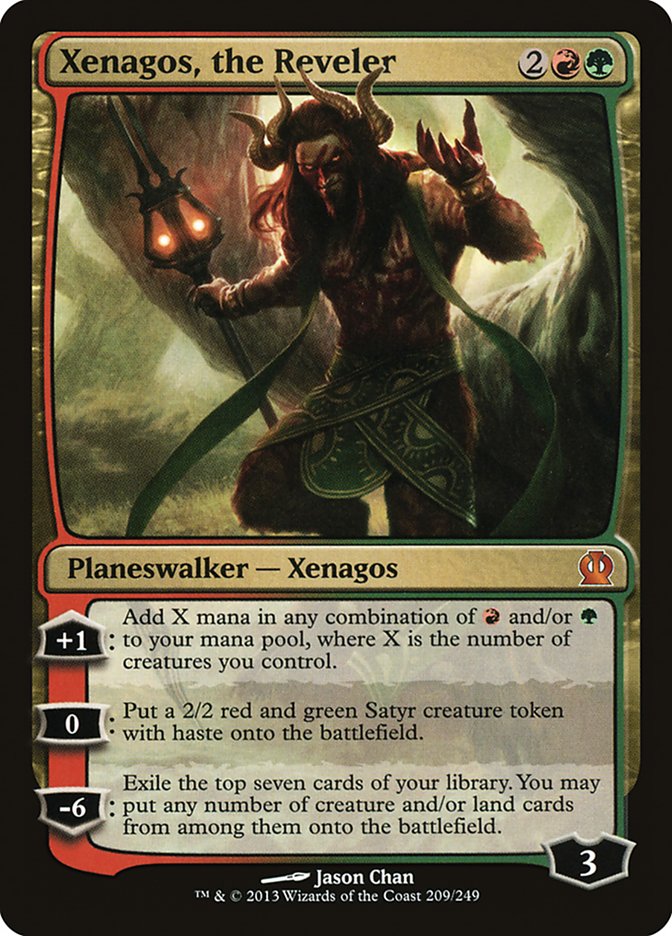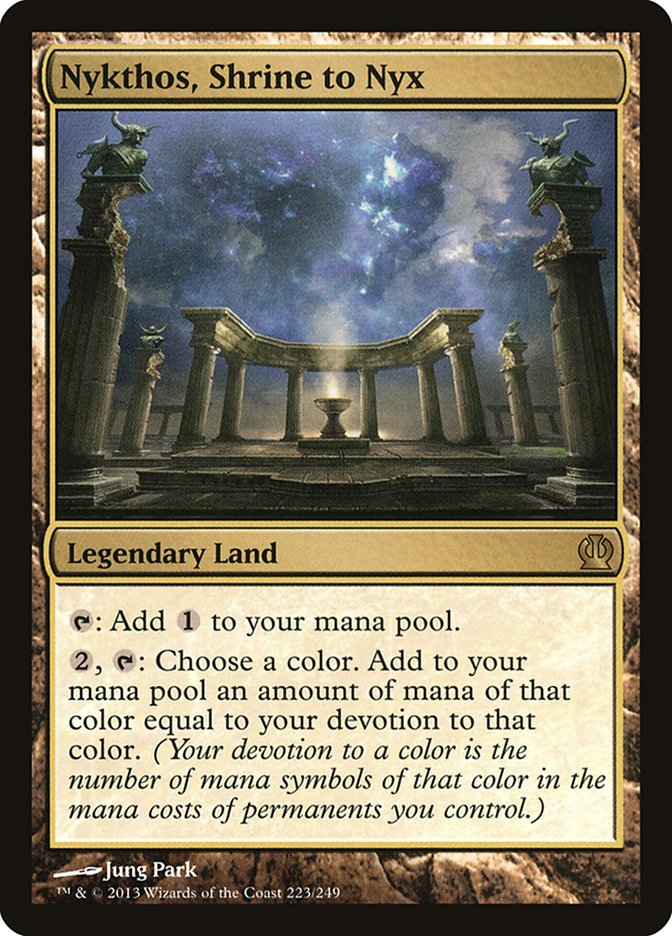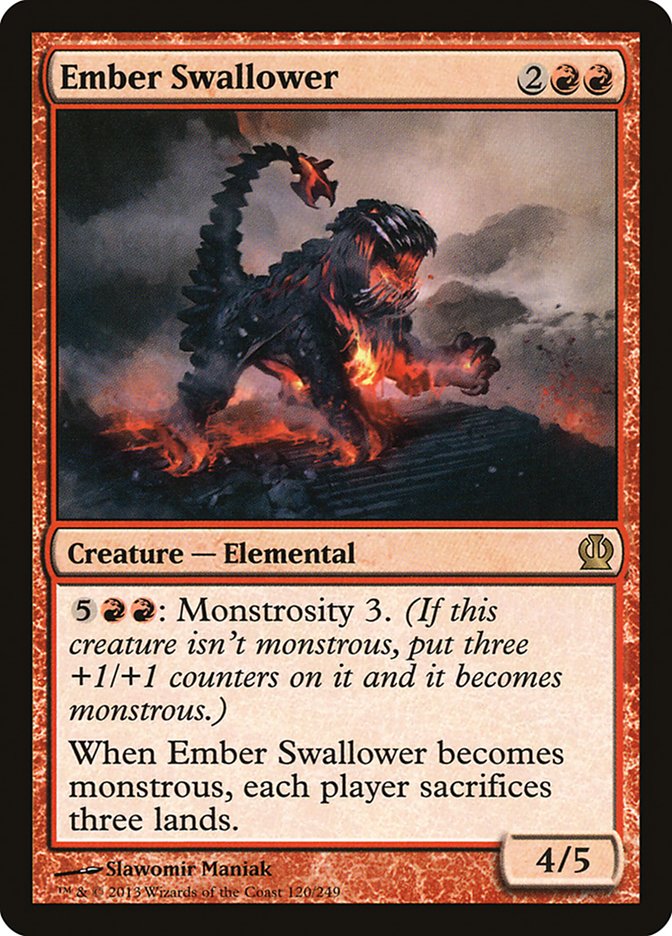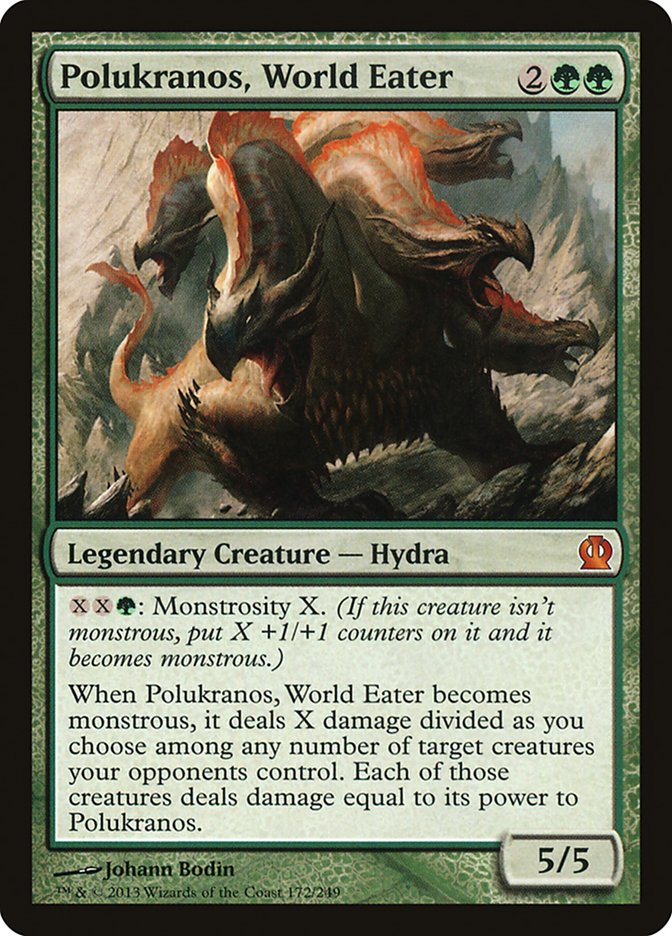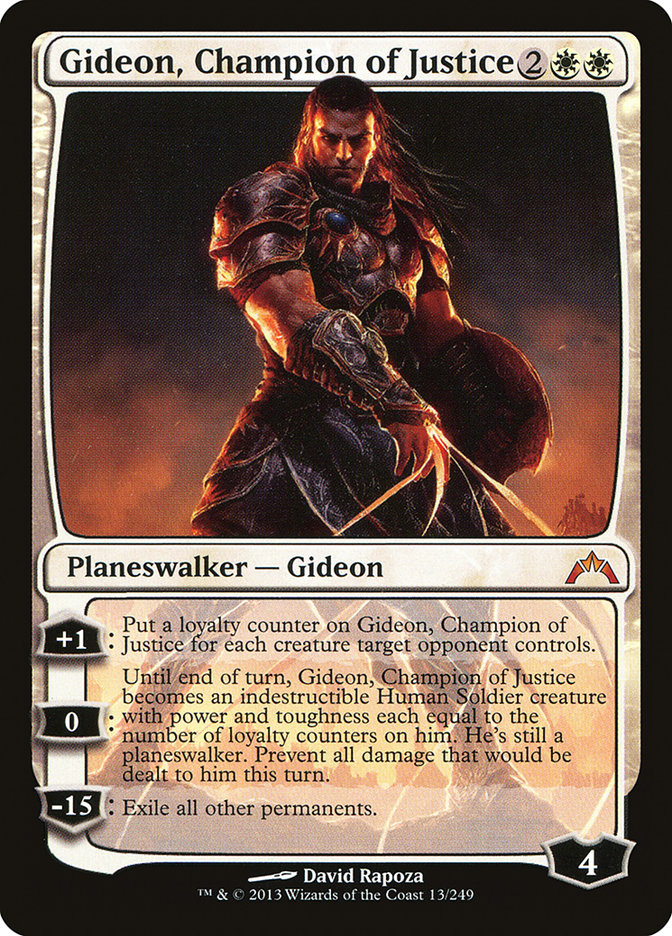While planeswalkers are hardly new at this point, they remain among the most interesting and difficult to evaluate cards most of the time they’re printed. In Theros, there are three:
First up, Ashiok, Nightmare Weaver. You’ll always use Ashiok’s +2 ability the turn it comes into play, which doesn’t impact the board, so you’re always passing with a five-loyalty planeswalker for three and not changing anything else in play. Five is a fair amount of loyalty for three, though not as much as it may have been in an era of smaller creatures. A fairly standard situation might be that they have a two-power creature, and you play Ashiok and use the +2. They attack Ashiok down to three and play another creature. Now, if you got lucky and hit a two-mana creature than can block with the +2, you can put Ashiok down to one and play that. Because they have two creatures, they’ll still be able to kill Ashiok, but you can still play something. If you play one guy or kill one of their creatures, Ashiok will live unless they can kill your creature, and then they’ll be able to kill Ashiok.
If they can attack for more than two when you play Ashiok, Nightmare Weaver, you’ll almost certainly have to use the +2 the next turn, which is clearly a losing battle unless you can do something to stop their attacks at that point.
If you can play Ashiok, Nightmare Weaver on an empty board against a creature-heavy deck, then you’re reasonably likely to be able to put a two-, three-, or four-mana creature in play with it on the next turn and keep your planeswalker in play. Now you have a real blocker and a planeswalker that can keep generating threats, and you’re probably in good shape. Still, the decks that are most likely to give you the right kind of creature to play are the decks that are least likely to give you an empty board.
Against a control deck, you’re unlikely to use Ashiok’s second ability, but the third ability becomes a real threat (whereas there’s almost no chance you’ll ever use it against a creature deck). If you can ultimate Ashiok and keep it in play against a control deck, you should win fairly easily.
Here, Ashiok comes down early and is a threat they absolutely have to answer. It powers up twice as fast as Liliana of the Veil (though it actually takes an extra activation to be able to ultimate it or the same number to ultimate it while leaving it in play against no resistance, but it stacks up better against minimal resistance). The weakness is that if they do kill it, most of the time the +2 ability won’t have really generated any lasting advantage while it was powering up. If I have Ratchet Bomb and you play Ashiok, you’ll get a few activations, but unless you get really lucky with them, I probably don’t care.
What I like about Ashiok is that it’s an extremely cheap threat that threatens entirely different kinds of things against control and against creatures and that the things it threatens generally seem relevant. The downside is that you need to work to protect Ashiok because it can’t protect itself.
All of this points to Ashiok, Nightmare Weaver as a finisher for a very dedicated control deck.
As a planeswalker, Ashiok would definitely like to be supported by some creatures to block—this card would love to play with Augur of Bolas and Snapcaster Mage, but they’re no longer legal. The obvious heir to that role is Omenspeaker, but whether that card is good enough to play is likely still a subject that’s up for debate. My early inclination is actually that it likely is, especially if Mono-Red Aggro is popular, where a 1/3 body is going to be helpful. It’s much worse if people are in the habit of attacking with Fleecemane Lions—unless those Lions are hanging out with Dryad Militant and Soldier of the Pantheon.
A deck built around Ashiok, Nightmare Weaver might look like this:
Creatures (4)
Planeswalkers (6)
Lands (25)
Spells (25)
- 2 Opportunity
- 2 Thoughtseize
- 1 Negate
- 2 Divination
- 2 Doom Blade
- 3 Essence Scatter
- 3 Ratchet Bomb
- 1 Ultimate Price
- 3 Far
- 1 Hero's Downfall
- 3 Dissolve
- 2 Pharika's Cure
Sideboard

The exact split of removal spells is very much still up in the air, as there are a lot of options that need to be tailored to the actual threats people are playing. I like Pharika’s Cure a lot here since there’s no other way to gain life, which I see as a fairly serious problem but not insurmountable. The deck gets to play a lot of removal, which is good with Ashiok and good against creature decks generally, while still being able to play a lot of extremely high-impact cards against other control decks, like Thoughtseize, planeswalkers, and counterspells.
Prognostic Sphinx helps lock down the board as a hard-to-kill blocker. It’s possible that more of it is better, but I just don’t have enough experience with it in Constructed to say for sure. The deck has a reasonable amount of incidental scry between Temple of Deceit, Omenspeaker, Dissolve, and Prognostic Sphinx, which should substantially help with this kind of deck’s general problem of needing the right answers at the right times.
Next up, Xenagos, the Reveler.
While Xenagos can play based on the 0 ability as a slightly upgraded (in that respect) Garruk Relentless, it will definitely be at its best in a deck that can really take advantage of the +1 ability. Toward that end, it’s going to want to play with a lot of creatures and some solid mana sinks. Fortunately, Theros is good enough to offer the perfect support for that: creatures that are mana sinks with monstrous.
With Xenagos, the Reveler, I want to dream big. Elvish Mystic is obvious, and I suspect every Xenagos deck will play it. Burning Tree-Emissary is another fairly obvious support card because it helps maximize the number of creatures you can get into play quickly, and it also works perfectly with the king of dreaming big: Nykthos, Shrine to Nyx.
Elvish Mystic by itself doesn’t give us enough creatures that tap for mana, but it’s our only option for one mana. That leaves us considering two-mana options, which can still let us play Xenagos, the Reveler on turn 3. Gyre Sage is a good mana producer that definitely dreams big, but I think it’s too hard to use to cast Xenagos on turn 3. Instead, I’d consider Zhur-Taa Druid, Satyr Hedonist, and Voyaging Satyr.
Satyr Hedonist isn’t exactly a mana dork, but if we’re trying to go big, it’s there to help. One easy play that it’s particularly good at setting up by itself is Garruk, Caller of Beasts on turn 3. That by itself seems good enough to seriously get my attention.
Putting those accelerators, planeswalkers, and some monstrous creatures together, we get a deck that looks something like this:
Creatures (28)
- 4 Burning-Tree Emissary
- 4 Zhur-Taa Druid
- 4 Elvish Mystic
- 4 Satyr Hedonist
- 4 Polukranos, World Eater
- 4 Ember Swallower
- 4 Voyaging Satyr
Planeswalkers (6)
Lands (24)
Spells (2)

Magical Christmas Land start for this deck:
Turn 1: Forest, Elvish Mystic.
Turn 2: Temple of Abandon, Burning-Tree Emissary, Voyaging Satyr.
Turn 3: Nykthos, Shrine to Nyx, tap Forest and Elvish Mystic to activate Nykthos for GGGG, tap Temple of Abandon for R, cast Xenagos, leaving G in your pool, use the +1 for three mana to go to GRRR, use Voyaging Satyr to untap Nykthos, and use GR to activate it for GGGGG, floating RR. Cast Garruk, Caller of Beasts and use the +1.
Turn 4: Cast everything
There are a variety of much less ambitious starts that still involve activating monstrous on Ember Swallower or Polukranos, World Eater for a reasonably large number on turn 4. The great thing about Ember Swallower is that it’s too big to kill with Mizzium Mortars, and if you monstrous it on turn 4, your opponent won’t really be able to do anything after that. Also note that with a second Burning-Tree Emissary things get way more absurd.
I’d really like another one-mana creature in this deck since just having Elvish Mystic doesn’t seem great, but at the same time, this is more of a midrange deck. Jund has certainly been able to get away with less.
Note the minimized removal, even in the sideboard. In true Zvi Mowshowitz fashion, this deck is optimized to just do one big thing, and it tries to avoid interaction as much as possible.
This deck has a strength against sweepers that many creature-based ramp decks in the past haven’t had in that it can just focus on planeswalkers, which it has access to an outstanding variety of.
Finally, let’s look at Elspeth, Sun’s Champion. Elspeth doesn’t look like a terribly interesting build-around card as much as just a big threat, but I think it might be possible to do better. I’m interested in pairing it with Nykthos, Shrine to Nyx as a durable permanent that adds to my devotion and a reasonable midrange mana sink for mana from Nykthos. Specifically, I’m interested in casting large Sphinx’s Revelations.
To do this, I want to try to fill the board with durable permanents that cost white mana, such as enchantments.
Creatures (1)
Planeswalkers (6)
Lands (26)
Spells (27)
- 3 Supreme Verdict
- 3 Martial Law
- 4 Detention Sphere
- 3 Sphinx's Revelation
- 4 Security Blockade
- 4 Sphere of Safety
- 4 Blind Obedience
- 2 Spear of Heliod
Sideboard

This deck is looking to lock up the board with enchantments, leading to an extremely long game where it has a pile of random permanents in play that allow Nykthos to tap for huge amounts of mana to cast enormous Sphinx’s Revelations or, even better, replay a handful of cards after ultimating Gideon, Champion of Justice.
Speaking of Gideon, he’s outstanding here, where you’re trying to allow your opponent to have creatures in play but preventing them from doing anything with Martial Law and Sphere of Safety. This allows him to power up quickly. The best way to win with Gideon is to add a large amount of mana to your mana pool, ultimate him, and cast a big threat. Elspeth by herself should be plenty, but as I mentioned earlier, Nykthos, Shrine to Nyx can allow for far more impressive follow-ups.
Note that I would love to play more copies of Nykthos, Shrine to Nyx but am hesitant do so when I’m planning to play such a long game because it’s legendary.
Elspeth can definitely be used as a finisher in a more traditional control deck or to support any token strategy, but this felt like the best fit to really maximize the strength of the card.
I think R&D did a great job with the planeswalkers in Theros, especially the gold ones, and I think we’ll see some great uses for all of them in Standard fairly quickly.
Thanks for reading,
Sam
@samuelhblack on Twitter
twitch.tv/samuelhblack


